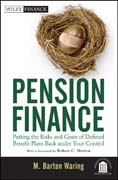
Pension finance: putting the risks and costs of defined benefit plans back under your control
Waring, M. Barton
Merton, Robert C.
INDICE: Foreword. Preface. List of Propositions. Acknowledgments. Chapter 1Achieving Long-Term Health for Pension Plans Using Improved Managerial Accounting Tools. Perspectives on DB Plans. What is Economic or Market-Value Accounting? What the Following Chapters Provide. Chapter 2 Today's Conventional Pension Finance Practices. Why Managers Need to Adopt the Economic Accounting Perspective. Where are we today? The Accounting Always Follows the Economics. Historical Context: The Actuaries' Contribution to the Existence of Pensions. Conclusion. Chapter 3 Measuring Meaningful Present Values. What is the Right Discount Rate to Use? The Liability-Matching Portfolio: General Perspective. Risk-Free Rate vs. Expected Return on Assets. If We Can Earn 7.5% Per Year Over The Long Term: Happy and Unhappy Distributions. The Employers Experience. The Discount Rate Is In Fact The Same On Both Sides Of The Full Economic Balance Sheet,But That Doesn't Mean That The Liability Changes Its Value With Changes In Investment strategy! GASB's White Paper and Public Employee Fund Discount Rates.Conclusion: Discount Rates. Appendix: Are There Market Values for Pension Plans? Chapter 4 The Full Economic Liability: The Off-Book Starting Point for Management of Pension Costs. The Liability: Inherently an Economic Entity. A Newly Formed Pension Plan. Multiple Correct Measures of the Accrued Portion of theLiability but Only One Parent Measure. Building a Pension Budget Identity. Chapter 5 Core Principles of Pension Accounting. The Full Economic Liability Meets Accrual Accounting and Normal Costs. Full Economic Normal Cost. Enter the Matching Principle: Normal Costs Accruing Over Time. Normal Costs and Retirees,Active Employees, and Future Employees. Normal Costs: Allocating Pension Costs to Current Employees. Payment Patterns Other Than Level Payments. Illustrating Normal Costs and Accrued and Total Liabilities over Time. Comparing Normal cost Methods. Normal Costs and Contributions: Multiple Measures? Normal Cost and Agreed Levels of Benefit Security: An Accrual Method Not Reliant on the Matching Principle. Balance Sheet with Accruals of an Economic Measure of Periodic Normal Cost. Updating the Beginning-Period Pension Budget Identity. Summary of Discussion of Normal Costs. Appendix: Computing Level-Payment Normal Costs with a Hand-Held Calculator In Order to Gain Understanding of the Nature of the Problem. Chapter 6 Credit Risk and the Discount Rate. Two Useful Views of the Liability's Value. Termination and Default Risk. Conclusion. Chapter 7 Paying for the Plan. Pension Expense and Contributions. Other Components of PensionExpense In Addition to Normal Cost. Distinguishing Economic from ConventionalSupplemental Costs. Economic Pension Expense. Economic Pension Expense in an Accrual System. Contributions to the Asset Pool, and the Sponsors Credit Risk.Investment Returns on Contributed Assets. Benefit Payments. The Components ofEconomically Determined Contributions. An Exam
- ISBN: 978-1-118-10636-5
- Editorial: John Wiley & Sons
- Encuadernacion: Cartoné
- Páginas: 320
- Fecha Publicación: 12/10/2011
- Nº Volúmenes: 1
- Idioma: Inglés
